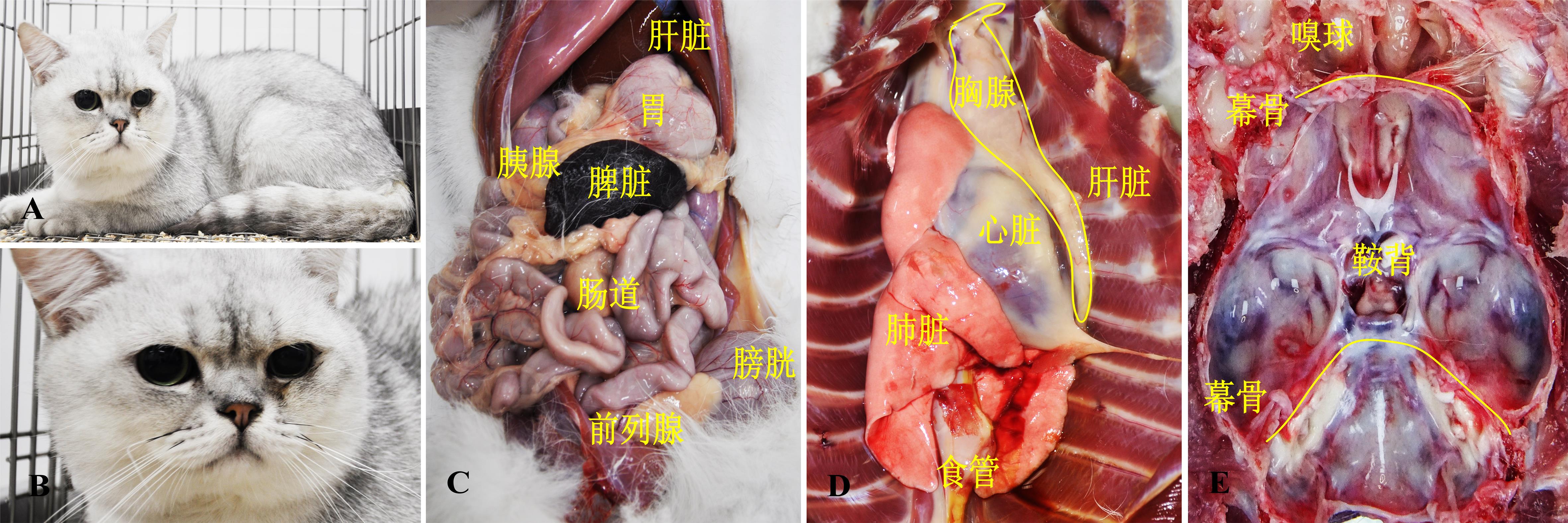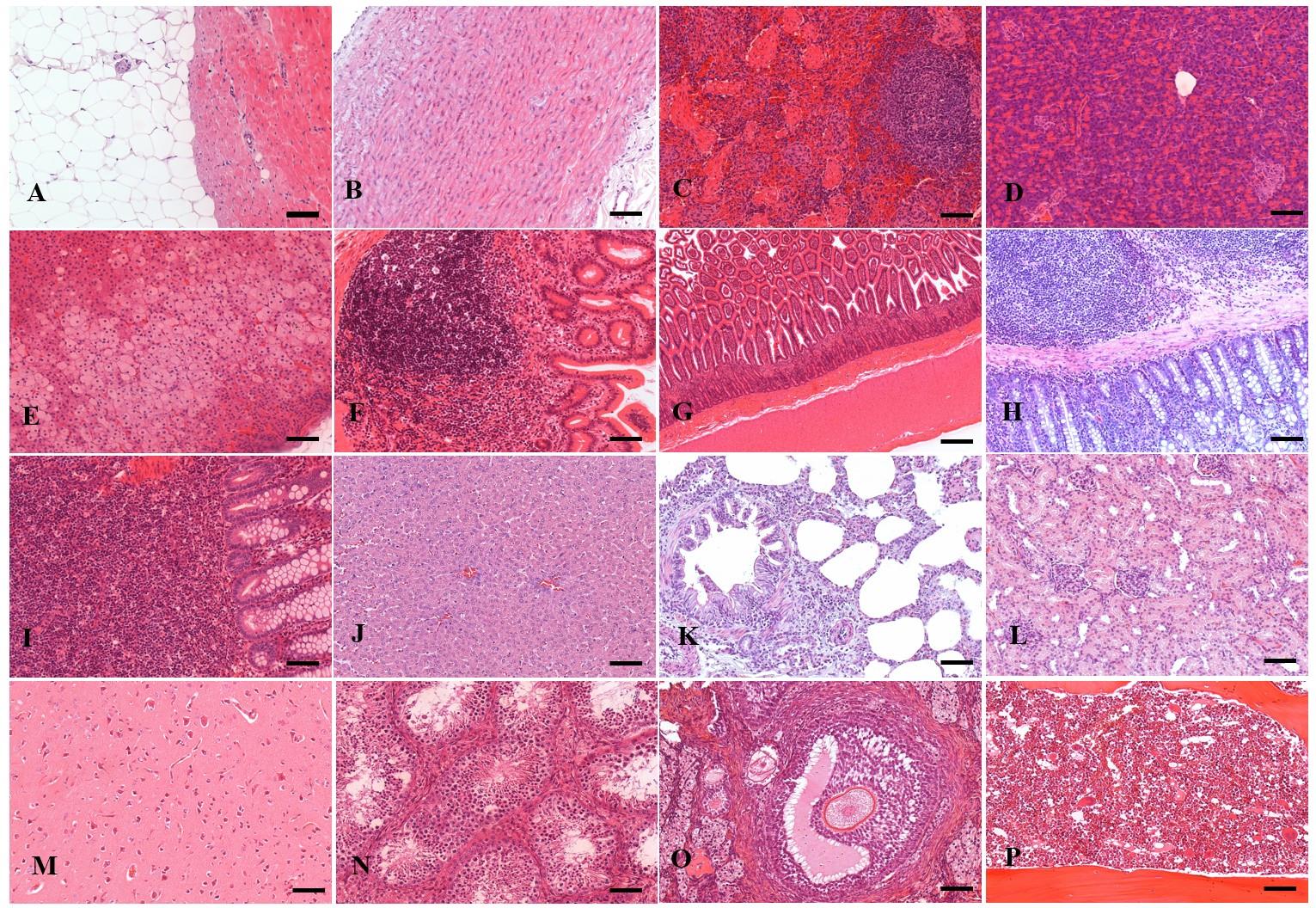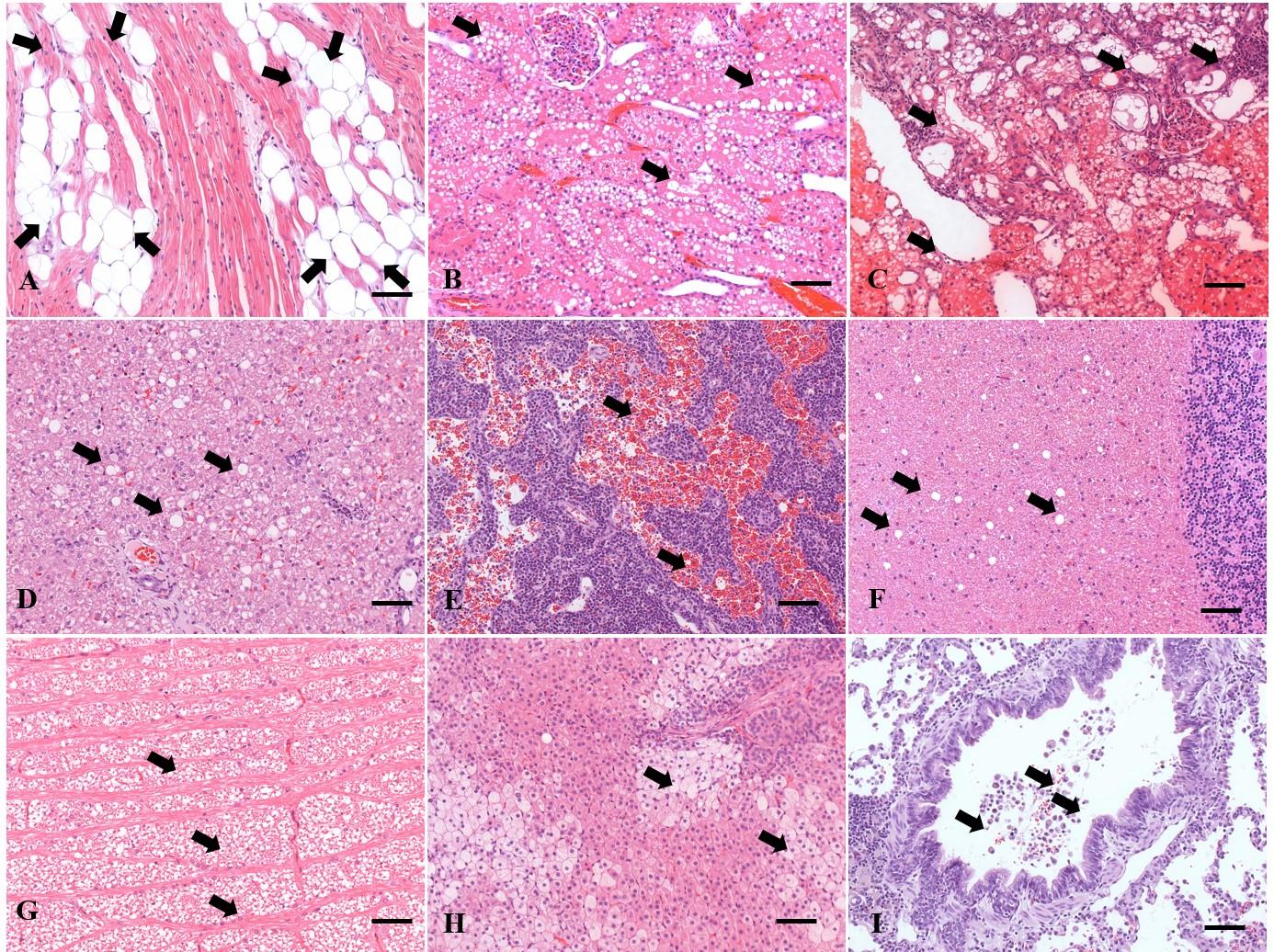
Laboratory Animal and Comparative Medicine ›› 2022, Vol. 42 ›› Issue (3): 229-236.DOI: 10.12300/j.issn.1674-5817.2021.151
Special Issue: 实验动物资源开发与利用
• Development and Utilization of Laboratory Animal Resources • Previous Articles Next Articles
Yu WANG( ), Dan GAO, Nana PENG, Ai HANG, Bin SHEN, Jian HUANG, Liming TANG(
), Dan GAO, Nana PENG, Ai HANG, Bin SHEN, Jian HUANG, Liming TANG( )(
)( )
)
Received:2021-09-14
Revised:2022-01-04
Online:2022-06-25
Published:2022-07-01
Contact:
Yu WANG, Liming TANG
CLC Number:
Yu WANG, Dan GAO, Nana PENG, Ai HANG, Bin SHEN, Jian HUANG, Liming TANG. Anatomical Characteristics and Background Lesions in Laboratory British-shorthair Cats[J]. Laboratory Animal and Comparative Medicine, 2022, 42(3): 229-236.
Add to citation manager EndNote|Ris|BibTeX
URL: https://www.slarc.org.cn/dwyx/EN/10.12300/j.issn.1674-5817.2021.151

Figure 1 The general appearance (A), facial view (B), abdominal cavity (C), thoracic cavity (D) and cranial cavity (E) of laboratory British-shorthair cats
| 雄性Male | 雌性 Female | ||||
|---|---|---|---|---|---|
脏器 Organ | 脏器平均质量 Organ weight/g | 脏器指数 Organ index/% | 脏器平均质量 Organ weight/g | 脏器指数 Organ index/% | |
| 心脏Heart | 17.72 ± 1.92 | 0.46 ± 0.09 | 10.35 ± 2.36 | 0.40 ± 0.02 | |
| 肝脏Liver | 103.34 ± 9.79 | 2.70 ± 0.50 | 69.32 ± 118.19 | 2.68 ± 0.57 | |
| 脾脏Spleen | 6.41 ± 0.46 | 0.71 ± 0.10 | 4.53 ± 1.16 | 0.18 ± 0.05** | |
| 肺脏Lung | 21.14 ± 1.61 | 0.55 ± 0.10 | 15.59 ± 1.36 | 0.61 ± 0.04 | |
| 肾脏Kidney | 38.30 ± 1.35 | 1.00 ± 0.15 | 23.72 ± 5.82 | 0.91 ± 0.08 | |
| 脑Brain | 27.40 ± 0.82 | 0.71 ± 0.10 | 26.71 ± 0.23 | 1.05 ± 0.13* | |
| 胸腺Thymus | 1.23 ± 0.43 | 0.03 ± 0.01 | 1.23 ± 0.43 | 0.05 ± 0.02* | |
| 肾上腺Adrenal | 0.65 ± 0.05 | 0.02 ± 0.00 | 0.71 ± 0.12 | 0.03 ± 0.01 | |
| 甲状腺Thyroid | 0.38 ± 0.01 | 0.01 ± 0.00 | 0.38 ± 0.03 | 0.01 ± 0.00 | |
| 睾丸Testis | 3.71 ± 0.28 | 0.10 ± 0.02 | - | - | |
| 卵巢Ovary | - | - | 0.72 ± 0.08 | 0.03 ± 0.00 | |
| 子宫Uterus | - | - | 3.50 ± 0.33 | 0.14 ± 0.02 | |
Table 1 Organ index of male and female laboratory British-shorthair cats
| 雄性Male | 雌性 Female | ||||
|---|---|---|---|---|---|
脏器 Organ | 脏器平均质量 Organ weight/g | 脏器指数 Organ index/% | 脏器平均质量 Organ weight/g | 脏器指数 Organ index/% | |
| 心脏Heart | 17.72 ± 1.92 | 0.46 ± 0.09 | 10.35 ± 2.36 | 0.40 ± 0.02 | |
| 肝脏Liver | 103.34 ± 9.79 | 2.70 ± 0.50 | 69.32 ± 118.19 | 2.68 ± 0.57 | |
| 脾脏Spleen | 6.41 ± 0.46 | 0.71 ± 0.10 | 4.53 ± 1.16 | 0.18 ± 0.05** | |
| 肺脏Lung | 21.14 ± 1.61 | 0.55 ± 0.10 | 15.59 ± 1.36 | 0.61 ± 0.04 | |
| 肾脏Kidney | 38.30 ± 1.35 | 1.00 ± 0.15 | 23.72 ± 5.82 | 0.91 ± 0.08 | |
| 脑Brain | 27.40 ± 0.82 | 0.71 ± 0.10 | 26.71 ± 0.23 | 1.05 ± 0.13* | |
| 胸腺Thymus | 1.23 ± 0.43 | 0.03 ± 0.01 | 1.23 ± 0.43 | 0.05 ± 0.02* | |
| 肾上腺Adrenal | 0.65 ± 0.05 | 0.02 ± 0.00 | 0.71 ± 0.12 | 0.03 ± 0.01 | |
| 甲状腺Thyroid | 0.38 ± 0.01 | 0.01 ± 0.00 | 0.38 ± 0.03 | 0.01 ± 0.00 | |
| 睾丸Testis | 3.71 ± 0.28 | 0.10 ± 0.02 | - | - | |
| 卵巢Ovary | - | - | 0.72 ± 0.08 | 0.03 ± 0.00 | |
| 子宫Uterus | - | - | 3.50 ± 0.33 | 0.14 ± 0.02 | |

Figure 2 The histopathological characteristics of the main tissues and organs of the laboratory British-shorthair cats detected by HE stainingNote: A is heart, B is aorta, C is spleen, D is pancreas, E is adrenal, F is stomach, G is jejunum, H is ileum, I is cecum, J is liver, K is lung, L is kidney, M is brain, N is testis, O is ovary, P is sternum. The scale of G is 1 000 μm, and the other images scale are 200 μm.

Figure 3 Background lesions of laboratory British-shorthair catsNote: Histopathological characteristics in the heart (A), kidney (B and C), liver (D), lymphonodi cervicales (E), cerebellum (F), brainstem (G), adrenal (H) and lung (I) of laboratory British-shorthair cats stained with H & E (Scale=200 μm). Arrows in A, B, D, F and G show the vacuolation (fatty) degeneration; arrows in C show the damaged tubular of kidney; arrows in E show the passive congestion of lymph sinus; arrows in H show the disorder structure of the zona fasciculata in the adrenal gland; arrows in I show the bronchus abscess in the lung.
| 1 | 国家药典委员会. 中华人民共和国药典 [S]. 北京: 中国医药科技出版社, 2020: 182-183. |
| Chinese Pharmacopoeia Commission. Pharmacopoeia of the People's Republic of China [S]. BeiJing: Chemical Industry Press, 2020:82–183. | |
| 2 | European Pharmacopoeia Commission. European Pharmacopoeia [S]. 10.0 edition. Stropean Directorate for Quality Medicines, 2019: 185. |
| 3 | SAMAHA G, BEATTY J, WADE C M, et al. The Burmese cat as a genetic model of type 2 diabetes in humans[J]. Anim Genet, 2019, 50(4):319-325. DOI:10.1111/age.12799 . |
| 4 | ROSSIGNOL S, CHAU C, GIROUX N, et al. The cat model of spinal injury[J]. Prog Brain Res, 2002, 137:151-168. DOI:10.1016/s0079-6123(02)37014-6 . |
| 5 | FREEMAN L M, RUSH J E, STERN J A, et al. Feline hypertrophic cardiomyopathy: a spontaneous large animal model of human HCM[J]. Cardiol Res, 2017, 8(4):139-142. DOI:10.14740/cr578w . |
| 6 | PAULIN M V, COURONNÉ L, BEGUIN J, et al. Feline low-grade alimentary lymphoma: an emerging entity and a potential animal model for human disease[J]. BMC Vet Res, 2018, 14(1):306. DOI:10.1186/s12917-018-1635-5 . |
| 7 | COATS K S. The feline immunodeficiency virus-infected cat: a model for lentivirus-induced placental immunopathology and reproductive failure (mini-review)[J]. Am J Reprod Immunol, 2005, 54(4):169-185. DOI:10.1111/j.1600-0897.2005.00296.x . |
| 8 | 方远书, 何忠平, 裘颖儿. 实验用猫研究现状和发展趋势探讨[J]. 山东畜牧兽医, 2017, 38(10):62. DOI:10.3969/j.issn.1007-1733.2017.10.044 . |
| FANG Y S, HE Z P, QIU Y E. Research status and development trend of laboratory cats[J]. Shandong J Animal Sci Vet Med, 2017, 38(10):62. DOI:10.3969/j.issn.1007-1733.2017.10.044 . | |
| 9 | 刘明慧, 袁宝, 陈健, 等. 猫实验动物标准化的研究进展及探讨[J]. 吉林畜牧兽医, 2015, 36(2):29-30, 32. DOI:10.3969/j.issn.1672-2078.2015.02.008 . |
| LIU M H, YUAN B, CHEN J, et al. Research progress and discussion on standardization of cat laboratory animals[J]. Jilin Animal Husb Vet Med, 2015, 36(2):29-30, 32. DOI:10.3969/j.issn.1672-2078.2015.02.008 . | |
| 10 | 滑志民, 张似青, 陈菊红, 等. 实验用猫的历史、发展现状及发展前景[J]. 上海畜牧兽医通讯, 2019(1):27-29. DOI:10.14170/j.cnki.cn31-1278/s.2019.01.007 . |
| HUA Z M, ZHANG S Q, CHEN J H, et al. History, development status and development prospect of experimental cats[J]. Shanghai J Animal Husb Vet Med, 2019(1):27-29. DOI:10.14170/j.cnki.cn31-1278/s.2019.01.007 . | |
| 11 | 何忠平, 王宜祥, 尤卫民, 等. 浙江省实验用猫弓形虫感染情况检测[J]. 浙江畜牧兽医, 2010, 35(3):36. DOI:10.3969/j.issn.1005-7307.2010.03.022 . |
| HE Z P, WANG Y X, YOU W M, et al. Detection of Toxoplasma gondii infection in experimental cats in Zhejiang Province[J]. Zhejiang J Animal Sci Vet Med, 2010, 35(3):36. DOI:10.3969/j.issn.1005-7307.2010.03.022 . | |
| 12 | 邢涛, 周光胜, 张敏, 等. 上海闵行区犬猫胃肠道寄生虫虫卵检测情况[J]. 中国兽医杂志, 2020, 56(12):83-86. |
| XING T, ZHOU G S, ZHANG M, et al. Detection of gastrointestinal parasite eggs in dogs and cats from Minhang District of Shanghai[J]. Chin J Vet Med, 2020, 56(12):83-86. | |
| 13 | HAAKE C, COOK S, PUSTERLA N, et al. Coronavirus infections in companion animals: virology, epidemiology, clinical and pathologic features[J]. Viruses, 2020, 12(9):1023. DOI:10.3390/v12091023 . |
| 14 | MURPHY W J. The feline genome[J]. Genome Dyn, 2006, 2:60-68. DOI:10.1159/000095093 . |
| 15 | 秦川. 医学实验动物学[M]. 北京: 人民卫生出版社, 2008: 113-117. |
| QIN Chuan. Medical Laboratory Animal Science[M]. Beijing: People's Medical Publishing House, 2008: 113-117. | |
| 16 | 胡樱, 杨斐, 陈鸿婷. 英国短毛实验猫部分血液生理生化特性分析[J]. 实验动物与比较医学, 2018, 38(6):450-454. |
| HU Y, YANG F, CHEN H T. Study on hematological and biochemical characteristics in laboratory British-shorthair cats[J]. Lab Animal Comp Med, 2018, 38(6):450-454. | |
| 17 | 景园园, 张明亮, 师航, 等. 郑州市猫皮肤病流行病学调查报告[J]. 当代畜牧, 2019(8):39-41. |
| JING Y Y, ZHANG M L, SHI H, et al. Epidemiological investigation report of cat dermatosis in Zhengzhou City[J]. Contemp Animal Husb, 2019(8):39-41. | |
| 18 | 辛萍萍. 英国短毛猫的日常洗护[J]. 黑龙江畜牧兽医, 2020(8):132-133, 152. DOI:10.13881/j.cnki.hljxmsy.2019.08.0126 . |
| XIN P P. Daily care of British short-haired cats[J]. Heilongjiang Animal Sci Vet Med, 2020(8):132-133, 152. DOI:10.13881/j.cnki.hljxmsy.2019.08.0126 . | |
| 19 | BOYD J S. 犬猫临床解剖彩色图谱[M]. 2版. 董军, 陈耀星,译. 北京: 中国农业大学出版社, 2007: 11-13. |
| BOYD J S. Color atlas of clinical anatomy of the dog & cat[M]. 2nd ed. Translated by DONG J, CHEN Y X. Beijing: China Agricultural University Press, 2007: 11-13. | |
| 20 | 肖宁宁. 深圳部分地区猫脂肪肝的临床调查与分析[D]. 阿拉尔:塔里木大学, 2021: 14-18. |
| XIAO N N. Clinical investigation and analysis of fatty liver in cats in some areas of Shenzhen [D]. Alar: Tarim University, 2021: 14-18. | |
| 21 | 叶妍琳, 白正广, 张斌恺, 等. 犬、猫肥胖症病因分析及管理[J]. 上海畜牧兽医通讯, 2015(1):62-63. DOI:10.14170/j.cnki.cn31-1278/s.2015.01.028 . |
| YE Y L, BAI Z G, ZHANG B K, et al. Etiological analysis and management of obesity in dogs and cats[J]. Shanghai J Animal Husb Vet Med, 2015(1):62-63. DOI:10.14170/j.cnki.cn31-1278/s.2015.01.028 . | |
| 22 | HOENIG M. The cat as a model for human obesity and diabetes[J]. J Diabetes Sci Technol, 2012, 6(3):525-533. DOI:10.1177/193229681200600306 . |
| 23 | 嵇扬, 张癸荣, 姜春来. 比格狗与猫对组胺降压作用敏感性的比较研究[J]. 中国药品标准, 2004, 5(2):38-39. DOI:10.19778/j.chp.2004.02.012 . |
| JI Y, ZHANG G R, JIANG C L. Study of comparison between beagles and cats on decrease blood pressure sensitivity to his tamine[J]. Drug Stanoaros China, 2004, 5(2):38-39. DOI:10.19778/j.chp.2004.02.012 . | |
| 24 | 黎家敏, 马佳丽, 杨春, 等. 实验兔和猫在降压物质检查中的比较研究[J]. 实验动物科学, 2020, 37(5):1-8. DOI:10.3969/j.issn.1006-6179.2020.05.001 . |
| LI J M, MA J L, YANG C, et al. Comparative study on the laboratory rabbits and cats in the test for depressor substances[J]. Lab Animal Sci, 2020, 37(5):1-8. DOI:10.3969/j.issn.1006-6179.2020.05.001 . | |
| 25 | LINTON M, NIMMO J S, NORRIS J M, et al. Feline gastrointestinal eosinophilic sclerosing fibroplasia: 13 cases and review of an emerging clinical entity[J]. J Feline Med Surg, 2015, 17(5):392-404. DOI:10.1177/1098612X14568170 . |
| 26 | BOLON B. Book review: background lesions in laboratory animals: a color atlas[J]. Toxicol Pathol, 2012, 40(4):700. DOI:10.1177/0192623312438230 . |
| [1] | Hongting CHEN, Fei YANG, Ying HU. Improving Effect of Environmental Enrichment on Stress-related Indicators of British-shorthair Cats [J]. Laboratory Animal and Comparative Medicine, 2022, 42(2): 152-158. |
| [2] | HU Ying, YANG Fei, CHEN Hong-ting. Study on Hematological and Biochemical Characteristics in Laboratory British-shorthair Cats [J]. Laboratory Animal and Comparative Medicine, 2018, 38(6): 450-454. |
| Viewed | ||||||
|
Full text |
|
|||||
|
Abstract |
|
|||||